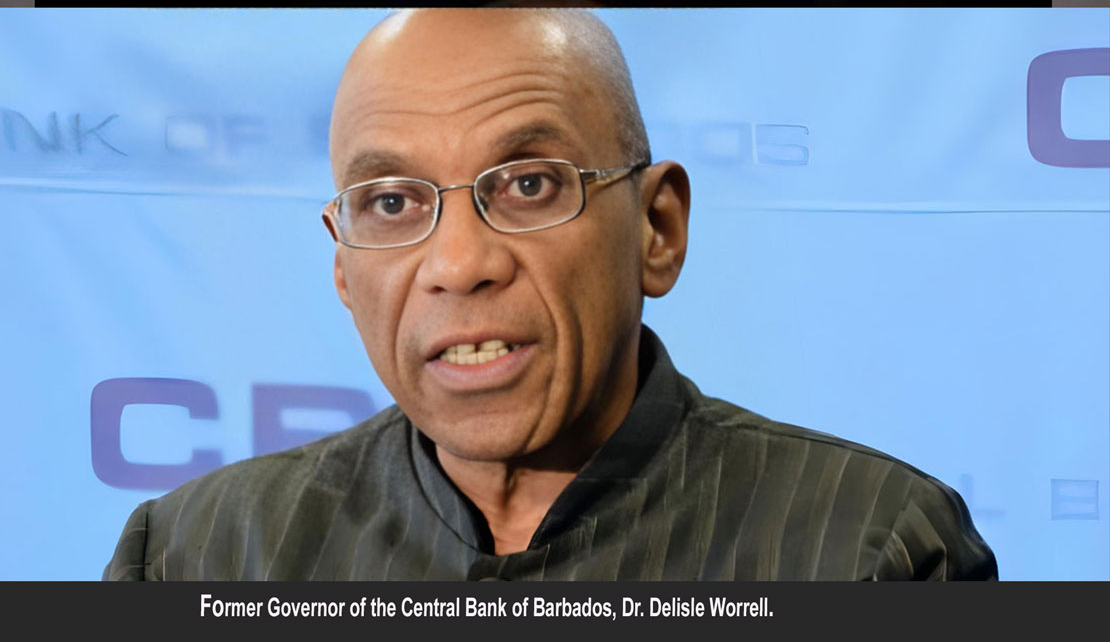BRIDGETOWN, Barbados August 22, 2023 - Former governor of the Central Bank of Barbados (CBB), Dr. DeLisle Worrell, is proposing that the adoption of the United States dollar as a common currency in the region would deepen Caribbean regional integration significantly.
Worrell said using United States dollars for all local businesses in place of the national currency, would further cement the demarche towards the CARICOM Single Market and Economy, CSCME, adding that “no CARICOM decision is needed for any country to reap that benefit.”
Several countries in the Caribbean have their currency, with the most stable being the Eastern Caribbean dollar, which is pegged to the US dollar at a rate of US 0.37 cents.
The Bahamas dollar trades at the equivalent of one US dollar, while Barbados’ dollar is pegged at 0.50 cents. Jamaica, Guyana, Trinidad and Tobago, and the Belize dollar fluctuate between 0.008 cents to .0.49 cents.
 In his ‘Economic letter,” Worrell said that over the five decades of CARICOM’s existence, Caribbean leaders have signed successive agreements committing the region to ever stronger cooperation, “all the while implementing policies that are more and more divergent. “In theory, CARICOM has gone from a free trade area to a common market, to a single market space, and now to a single economy, implying commonality of financial and commercial regulation and standard rules and procedures.
In his ‘Economic letter,” Worrell said that over the five decades of CARICOM’s existence, Caribbean leaders have signed successive agreements committing the region to ever stronger cooperation, “all the while implementing policies that are more and more divergent. “In theory, CARICOM has gone from a free trade area to a common market, to a single market space, and now to a single economy, implying commonality of financial and commercial regulation and standard rules and procedures.
“The reality is that each member country has its internal systems, and the laws, rules, and procedures governing the movement of goods, people, and finance between members are the same as for the US, UK, Canada, or any other non-CARICOM country.”
“The Caribbean is unquestionably more integrated today than it was 50 years ago. Since that time Trinidad’s style of Carnival has spread into the diaspora and across the region; Jamaican music has become a world phenomenon, with variants springing up everywhere, including in the Caribbean.
“Caribbean literature attracts readership across the English-speaking world and in the region; and thanks to many decades of emigration, and the presence of large communities of Caribbean people in major cities in North America and the UK, almost everyone has personal links of family and friendship across the region,” Worrell wrote.
But he argued that “this is not the pattern of regional integration which the Caribbean leadership has in mind.
“But it has developed organically to the benefit of the region’s people, providing rich and dynamic cultural experiences for us to enjoy and celebrate, and enriching livelihoods for cultural practitioners, regional economies and everyone who benefits from remittances, pensions and other income from abroad. Ironically, it is often in Miami, New York or Toronto that we feel most Caribbean.”
He said that in the 1960s and early 1970s, newly-independent Caribbean countries actively collaborated in designing economic policies, with the participation and advice of renowned scholars associated with the University of the West Indies and the Sir Arthur Lewis Institute, then known as the Institute for Social and Economic Research (ISER).
He said when the United Kingdom devalued the pound sterling against the US dollar on November 18, 1968, Caribbean countries approached the UWI to advise whether they should follow suit.
Worrell said the ISER arranged for studies to be prepared, and a conference was held to discuss the pros and cons.
“Encouraged by the insights that the exercise yielded, the region’s central banks and the UWI set up a permanent program for regional economic policy research. That Programme evolved into the Caribbean Centre for Money and Finance, which I headed for a brief decade and a half ago. The Centre has since been dissolved, its services no longer needed now that there is no longer any interest in regional policy coordination.”
Worrell said that the economic thinkers whose work influenced the formation of CARICOM saw economic integration as a tool to promote the diversification of the region’s exports beyond sugar, bananas, oil, and bauxite.
-30-

